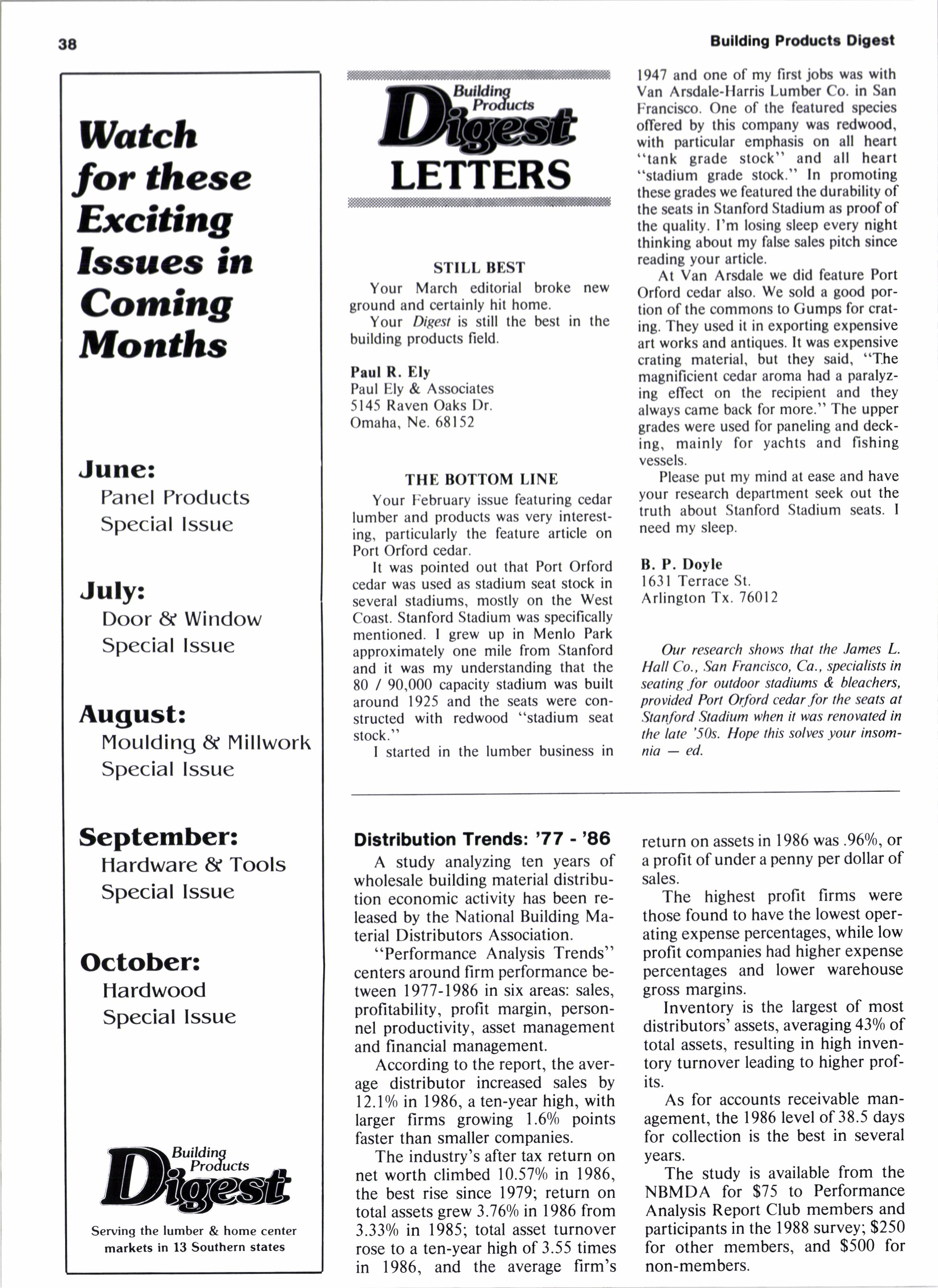
2 minute read
Watch for these ExciJing Issues 3n Coming Ilrlonths
June: Panel Products Special lssue
Still Best
Your March editorial broke new ground and certainly hit home. Your Ddgesl is still the best in the building products field.
Prul R. Ely
Paul Ely & Associates
5145 Raven Oaks Dr. Omaha. Ne.68152
The Bottom Line
Your February issue featuring cedar lumber and products was very interesting, particularly the feature article on Port Orford cedar.
1947 and one of my first jobs was with Van Arsdale-Harris Lumber Co. in San Francisco. One of the featured species offered by this company was redwood, with particular emphasis on all heart "tank grade stock" and all heart "stadium grade stock." In promoting these grades we featured the durability of the seats in Stanford Stadium as proof of the quality. I'm losing sleep every night thinking about my false sales pitch since reading your article.
At Van Arsdale we did feature Port Orford cedar also. We sold a good portion of the commons to Gumps for crating. They used it in exporting expensive art works and antiques. It was expensive crating material, but they said, "The magnificient cedar aroma had a paralyzing effect on the recipient and they always came back for more." The upper grades were used for paneling and decking, mainly for yachts and fishing vessels.
Please put my mind at ease and have your research department seek out the truth about Stanlord Stadium seats. I need my sleep.
July: Door Er Window Special lssue Moulding & Millwork Special lssue
August:
September: Hardware & Tools Special Issue
October: Hardwood Special lssue
It was pointed out that Port Orford cedar was used as stadium seat stock in several stadiums, mostly on the West Coast. Stanford Stadium was specifically mentioned. I grew up in Menlo Park approximately one mile from Stanford and it was my understanding that the 80 / 90,000 capacity stadium was built around 1925 and the seats were structed with redwood "stadium stock."
I started in the lumber business in
Dlstrlbution Trends: '77 -'86
A study analyzing ten years of wholesale building material distribution economic activity has been released by the National Building Material Distributors Association.
"Performance Analysis Trends" centers around firm performance between 1977-1986 in six areas: sales, profitability, profit margin, personnel productivity, asset management and financial management.
According to the report, the average distributor increased sales by 12.10/o in 1986, a ten-year high, with larger firms growing l.60lo points faster than smaller companies.
The industry's after tax return on net worth climbed 10.570/o in 1986, the best rise since 1979; return on total assets grew 3.760/o in 1986 from 3.330/o in 1985; total asset turnover rose to a ten-year high of 3.55 times in 1986, and the average firm's
B. P. Doyle l63l Terrace St. Arlington Tx.76012
Our research shows that the James L. Hall Co., San Francisco, Ca., specialists in seoting for outdoor stadiums & bleachers, provided Port Orford cedar for the seats at Stanford Stadium when it was renowted in the late '50s. Hope this solws your insomniaed.
return on assets in 1986 was .960/0, or a profit of under a penny per dollar of sales.
The highest profit firms were those found to have the lowest operating expense percentages, while low profit companies had higher expense percentages and lower warehouse gross margins.
Inventory is the largest of most distributors' assets, averaging 43o/o of total assets, resulting in high inventory turnover leading to higher profits.
As for accounts receivable management, the 1986 level of 38.5 days for collection is the best in several years.
The study is available from the NBMDA for $75 to Performance Analysis Report Club members and participants in the 1988 survey; $250 for other members, and $500 for non-members.
It ClllCAG0 lor the Home Center Show: (ll Carl Holland, Robert










